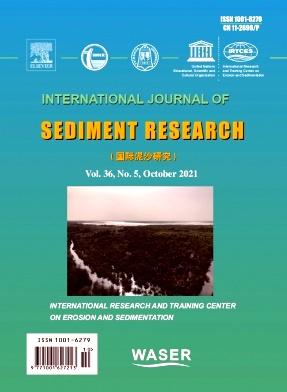基于沉积元素记录和碳氮同位素组成的北部湾北部沿海地区环境演化
IF 3.7
2区 环境科学与生态学
Q2 ENVIRONMENTAL SCIENCES
引用次数: 0
摘要
阐明海岸带生物成因元素和物源的历史变化,对于更好地认识海岸带环境演化和组织生态管理具有重要意义。通过对北部湾北部沿海地区沉积物中生物源元素(碳(C)、氮(N)、磷(P)、硅(Si))和碳、氮同位素(δ13C和δ15N)的时空分布特征的研究,揭示了北部湾北部沿海地区沉积物有机质(SOM)的元素变化和来源。C、N、P含量从河口向近海呈总体递减趋势,这可能与陆源输入和沉积物结构有关。由于Si主要与硅藻有关,因此Si的降低可归因于方城湾和茅尾海河口牡蛎床浮游植物生长的抑制。基于δ13C和δ15N三端元混合模型,研究发现集约海水养殖区(IMR)陆源植物和贝类生物沉积对SOM的平均贡献分别为56.00%和22.39%,表明陆源和海水养殖生物沉积对SOM的来源起着突出作用。此外,根据3个210 (210Pb)定年的沉积物岩心,发现20世纪80年代以后,特别是2006年北部湾经济区建立以来,元素含量和元素埋藏率随着沿海的发展而增加。多元线性回归结果表明,C、N含量和沉积速率是近几十年来碳埋藏率变化的主要原因。更重要的是,元素含量与人口、国内生产总值(GDP)增长呈显著正相关,进一步证明了CNBG环境演变与广西社会经济发展密切相关。此外,3个沉积物岩心SOM源贡献的不同趋势也体现了不同海岸环境下的演化特征。δ13C和δ15N的升高表明,近年来三娘湾海洋浮游植物对SOM的贡献增加(46.83% ~ 69.33%),藻华的频繁发生和分解导致了SOM的增加。连州湾陆地源对SOM的主导比例(76.50%±13.27%,±表示标准差界限)表明近百年来河流输入和渔业活动对SOM的影响显著。本研究表明,人类活动导致营养物质持续增加,造成了CNBG藻华等生态风险,因此,缓解沿海富营养化需要密切关注。本文章由计算机程序翻译,如有差异,请以英文原文为准。

Environmental evolution of coastal regions in northern Beibu Gulf, South China, based on sedimentary elemental records and carbon-nitrogen isotope composition
Elucidating the historical variation of biogenic elements and source provenance in coastal areas is crucial to better understand environmental evolution and organize ecological management. In this study, the spatiotemporal distribution of biogenic elements (carbon (C), nitrogen (N), phosphorus (P), and silicon (Si)), and carbon and nitrogen isotopes (δ13C and δ15N), respectively in sediment were explored to illustrate elemental changes and determine sources of sedimentary organic matter (SOM) in the coastal regions of northern Beibu Gulf (CNBG). C, N, and P contents exhibited a general decreasing pattern from estuaries to offshore areas, probably due to terrigenous inputs and sediment textures. Since Si was mainly associated with diatoms, lower Si was attributed to the depression of phytoplankton growth by oyster beds in estuaries of Fangcheng Bay and the Maowei Sea. Based on a δ13C and δ15N three-end-member mixing model, it revealed that the average contribution of terrigenous plants and shellfish biodeposition for SOM were 56.00% and 22.39% in the intensive mariculture region (IMR), indicating that terrestrial sources and mariculture biodeposits played a prominent role as SOM sources. Additionally, according to three lead 210 (210Pb) dated sediment cores, it was found that elemental contents and elemental burial rates increased along with the coastal development after 1980s, particularly since 2006 when the Beibu Gulf Economic Zone was established. Multiple Linear Regression results showed that C and N contents and sedimentation rates were responsible for the variation of carbon burial rates during the past decades. More importantly, the significant positive relation between elemental contents and population, and gross domestic product (GDP) growth further proved a close relation between environmental evolution in the CNBG and the socioeconomic development of Guangxi Province. Moreover, the different trends of SOM source contribution for three sediment cores demonstrated the evolution characteristics among different coastal environments. The elevated δ13C and δ15N manifested the increasing contribution of marine phytoplankton (46.83%–69.33%) to SOM in Sanniang Bay recently, where frequent occurrence and decomposition of algal blooms resulted in more SOM. The dominant fraction of terrestrial sources (76.50% ± 13.27%, where ± indicates a standard deviation bound) to SOM in Lianzhou Bay implied the significant impacts of riverine inputs and fishing activities during the last century. This study indicates human activities have led to the continuous increase in nutrients, which has caused ecological risks such as algal blooms in the CNBG, thus, the mitigation of coastal eutrophication needs close attention.
求助全文
通过发布文献求助,成功后即可免费获取论文全文。
去求助
来源期刊
CiteScore
6.90
自引率
5.60%
发文量
88
审稿时长
74 days
期刊介绍:
International Journal of Sediment Research, the Official Journal of The International Research and Training Center on Erosion and Sedimentation and The World Association for Sedimentation and Erosion Research, publishes scientific and technical papers on all aspects of erosion and sedimentation interpreted in its widest sense.
The subject matter is to include not only the mechanics of sediment transport and fluvial processes, but also what is related to geography, geomorphology, soil erosion, watershed management, sedimentology, environmental and ecological impacts of sedimentation, social and economical effects of sedimentation and its assessment, etc. Special attention is paid to engineering problems related to sedimentation and erosion.

 求助内容:
求助内容: 应助结果提醒方式:
应助结果提醒方式:


